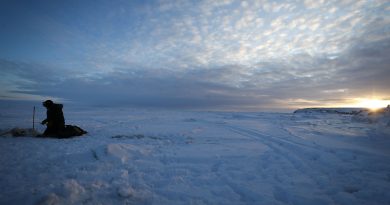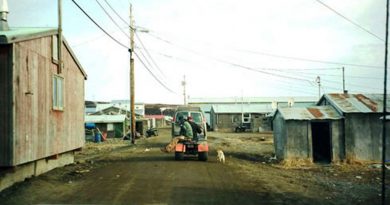Business boom follows glacier’s retreat in Portage, southcentral Alaska

Portage Glacier Cruises, south of Anchorage in southcentral Alaska, recently marked its 30th anniversary of shuttling visitors by boat to its namesake glacier.
Over time, employees have seen the recession of Portage Glacier first hand. What does that mean for a company whose business is based on this particular piece of snow and ice?
On the deck of the M/V Ptarmigan, Captain Marcelle Roemmich led a small crowd of visitors, and current and former employees, in a toast.
Behind Roemmich sits a massive, frozen variable in the company’s future. Portage Glacier stands tall on the far end of the lake. A wall of white and blue ice.
A long time ago, the glacier filled the entire Portage Valley. But, in the last century, the glacier has gotten way smaller — retreating further and further up the valley, opening up the lake, and making it difficult to see without traveling out on the water.
Most of that retreat, according to the U.S. Geological Survey, was driven by the calving of unstable ice. The organization says a warming climate contributed on a smaller scale. Now, that’s the factor driving continued ice loss.
Bill Lazarus — Laz, as he’s known on the boat — worked as an engineer for the company for 15 years, until 2012.
Now, he stands on the ship’s deck again, looking at the smaller, but still-massive piece of ice towering over the lake.
“When I started, this face of this rock was all that showed,” Lazarus said. “The ice was right on top of it. From here you could see ice on both sides, and it’s just gone back incredibly.”
Lazarus says he even remembers when the glacier could be seen from shore, at the Begich, Boggs Visitor Center.
“I can picture standing in the parking lot at the visitor’s center when the glacier went straight across the lake,” Lazarus said. “So it was all the way around the corner.”
The visitor center was built in 1986. It’s run by the U.S. Forest Service. Alicia King, with the Forest Service, says it was built on glacial moraine. That’s dirt and rock that gets left behind by a glacier as it moves. When it was built three decades ago, the visitor center’s location was chosen for a reason.
“Because of the spectacular view of Portage Glacier,” King said. “The theater of the Begich Boggs Visitor Center opens up to what’s now mostly lake.”
A gradual retreat
Back on the shore, Tom Callahan is sitting at a picnic bench, watching the M/V Ptarmigan pull up to the dock. Callahan is recently retired boat captain. He worked for the company for 23 years.
“I saw the glacier every day, five times a day. So it’s a bit like having a child,” Callahan said. “They look the same every day to you, and all of a sudden they’re borrowing your car.”
As for the glacier, “I can’t say that I saw dramatic, big changes,” Callahan said. “It was just a little bit year by year.”
In recent years, Callahan says he’s seen the rate of recession slow way down. And it has. According to the US geological survey, the most rapid period of recession happened in the 20th century.
Still, as the earth’s climate warms, the glacier will likely continue to shrink.
Even so, after 30 years in business, Portage Glacier Cruises is experiencing more business than ever.
As the glacier shrinks, business is growing, with a record last year of 36,000 visitors.
Related stories from around the North:
Canada: Dramatic changes to Yukon glaciers a warning for the planet, researchers say, CBC News
Finland: Giant cruise ships bringing tourists in record numbers to Helsinki, Yle News
Greenland: Glacier half the size of Manhattan breaks off Greenland, CBC News
Norway: Antarctic-to-Arctic ultra-luxury cruise announced for 2022, The Independent Barents Observer
Russia: Luxury cruises lured by Arctic Russia, The Independent Barents Observer
Sweden: Scientists in Sweden help Indian farmers with artificial glaciers, Radio Sweden
United States: When the ice melts, what will happen to Arctic tourism?, Cryopolitics Blog



